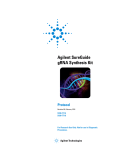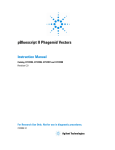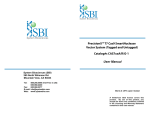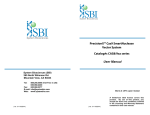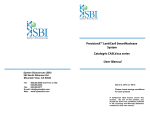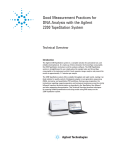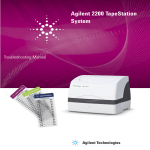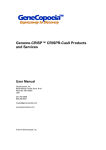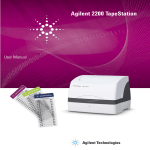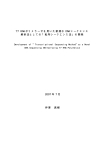Download Agilent SureGuide Cas9 Nuclease Kit
Transcript
Agilent SureGuide Cas9 Nuclease Kit Protocol Revision B0, February 2015 5190-7714 5190-7715 5190-7716 5190-7718 For Research Use Only. Not for use in Diagnostic Procedures. Agilent Technologies Notices © Agilent Technologies, Inc. 2015 Warranty No part of this manual may be reproduced in any form or by any means (including electronic storage and retrieval or translation into a foreign language) without prior agreement and written consent from Agilent Technologies, Inc. as governed by United States and international copyright laws. The material contained in this document is provided “as is,” and is subject to being changed, without notice, in future editions. Further, to the maximum extent permitted by applicable law, Agilent disclaims all warranties, either express or implied, with regard to this manual and any information contained herein, including but not limited to the implied warranties of merchantability and fitness for a particular purpose. Agilent shall not be liable for errors or for incidental or consequential damages in connection with the furnishing, use, or performance of this document or of any information contained herein. Should Agilent and the user have a separate written agreement with warranty terms covering the material in this document that conflict with these terms, the warranty terms in the separate agreement shall control. Manual Part Number 5990-7262 Edition Revision B0, February 2015 Agilent Technologies, Inc. 5301 Stevens Creek Blvd Santa Clara, CA 95051 For Research Use Only. Not for use in Diagnostic Procedures. Technology Licenses The hardware and/or software described in this document are furnished under a license and may be used or copied only in accordance with the terms of such license. Restricted Rights Legend If software is for use in the performance of a U.S. Government prime contract or subcontract, Software is delivered and licensed as “Commercial computer software” as defined in DFAR 252.227-7014 (June 1995), or as a “commercial item” as defined in FAR 2.101(a) or as “Restricted computer software” as defined in FAR 52.227-19 (June 1987) or any equivalent agency regulation or contract clause. Use, duplication or disclosure of Software is subject to Agilent Technologies’ standard commercial license terms, and non-DOD Departments and Agencies of the U.S. Government will receive no greater than Restricted Rights as defined in FAR 52.227-19(c)(1-2) (June 1987). U.S. Government users will receive no greater than Limited Rights as defined in FAR 52.227-14 (June 1987) or DFAR 252.227-7015 (b)(2) (November 1995), as applicable in any technical data. Safety Notices CAUTION A CAUTION notice denotes a hazard. It calls attention to an operating procedure, practice, or the like that, if not correctly performed or adhered to, could result in damage to the product or loss of important data. Do not proceed beyond a CAUTION notice until the indicated conditions are fully understood and met. WA R N I N G A WARNING notice denotes a hazard. It calls attention to an operating procedure, practice, or the like that, if not correctly performed or adhered to, could result in personal injury or death. Do not proceed beyond a WARNING notice until the indicated conditions are fully understood and met. Agilent SureGuide Cas9 Nuclease Kit Protocol Agilent SureGuide Cas9 Programmable Nuclease Kit Kit Components and Storage Conditions 4 Required and Optional Equipment and Reagents 5 Introduction to the Cas9 Nuclease 6 Preprotocol Considerations 8 Ratio of Cas9 to target 8 Guide RNA 8 Temperature 8 Generation of blunt end fragments 9 Procedures 10 Digest DNA with Cas9 nuclease 10 Interpretation of the Control Reaction Results 12 Reference 14 Agilent Technologies 3 Kit Components and Storage Conditions Component SureGuide CRISPR/Cas Complete Kit, p/n 5190-7714 SureGuide Cas9 Programmable Nuclease Kit, 20 Reactions, p/n 5190-7715 SureGuide Cas9 Programmable Nuclease Kit, 100 Reactions, p/n 5190-7716 Storage Temperature Cas9 Nuclease 40 µL 20 µL 100 µL –20°C 10X Cas9 Digestion Buffer 2 × 40 µL 40 µL 200 µL –20°C RNase Free Water 2 × 1.5 mL 1.5 mL 2 x 1.5 mL –20°C Control DNA Target, 50 ng/μL 2 × 20 µL 20 µL 20 µL –20°C Control gRNA, 1 μM 2 × 10 µL 10 µL 10 µL –20°C T7 Promoter Forward Primer 25 µL — — –20°C Control Template 50 µL — — –20°C DTT 50 µL — — –20°C RNAse Free DNAse 50 µL — — –20°C T7 RNA Polymerase 50 µL — — –20°C 100 mM rATP 50 µL — — –20°C 100 mM rGTP 50 µL — — –20°C 100 mM rUTP 50 µL — — –20°C 100 mM rCTP 50 µL — — –20°C 5X RNAMaxx Transcription Buffer 250 µL — — –20°C Yeast Pyrophosphatase 25 µL — — –20°C RNase Block 50 µL — — –20°C DEPC treated water 1 mL — — –20°C gRNA Binding Buffer 5 mL — — Room temperature 5X gRNA Wash Buffer 7 mL — — Room temperature gRNA Elution Buffer 2.5 mL — — Room temperature RNA Binding Spin Cups and 2-mL Receiver Tubes 50 each — — Room temperature Tube, Micro 1.5-mL 50 each — — Room temperature 4 490 Micro GC User Manual Required and Optional Equipment and Reagents Table 1 Required and optional equipment and reagents for the Cas9 nuclease protocol Equipment or Reagent Thermocycler or temperature blocks at 30°C and 65°C Nuclease-free labware (e.g. reaction tubes) (Optional) Agilent 2200 TapeStation system, p/n G2964AA or G2965AA (Optional) Agilent Genomic DNA ScreenTape for the 2200 TapeStation system, p/n 5067-5365 or 5067-5366 (Optional) Agilent TapeStation DNA analysis platform and consumables We recommend analyzing the Cas9 digestion control reaction using the Agilent Genomic DNA ScreenTape. The 2200 TapeStation analysis software can then be used to calculate the Cas9 cleavage efficiency. 490 Micro GC User Manual 5 Introduction to the Cas9 Nuclease Cas9 (CRISPR associated protein 9) is an RNA- guided DNA nuclease associated with Type II bacterial CRISPR immunity systems. Cas9 is widely used to induce site- specific double strand breaks in DNA for multiple applications, many of which have yet to be developed. The guide RNA (gRNA) structure that binds and directs Cas9 is a hybrid of CRISPR RNA, containing homologous sequence to the cleavage target, and a trans- activating tracrRNA. A single guide RNA (sgRNA) chimera of the CRISPR and tracrRNAs can also direct DNA cleavage by Cas9 in vitro in lieu of the naturally occurring duplex1. The kit includes a recombinant Cas9 nuclease, a 10X digestion buffer, a linear plasmid control target, and a corresponding gRNA. The guidelines and reaction conditions provided were optimized using linear DNA targets ranging from 3 kb–15 kb in reaction volumes of 10–20 µL. You are required to provide your experimental DNA targets and gRNAs in addition to optimizing the best reaction conditions for your unique application. We recommend the Agilent SureGuide gRNA Synthesis Kit (p/n 5190- 7719) for synthesizing your gRNAs. 6 490 Micro GC User Manual Figure 1 Depiction of gRNA directed Cas9 cleavage of double stranded DNA 490 Micro GC User Manual 7 Preprotocol Considerations The reaction kinetics are determined by the total number of PAM sequences in the target DNA as well as relative concentrations of the three participant components: Target DNA, Cas9 and guide RNA. It may be necessary for you to empirically determine the optimal reaction conditions for your unique application. Ratio of Cas9 to target An excess of Cas9 results in aggregation of the target DNA and no observable cleavage. If too little Cas9 is used, it can result in low cleavage efficiencies. To determine the optimal amount of Cas9 to add to a given reaction, perform test digestions with a dilution series of Cas9. The protocol provided here is adequate for digestion of most plasmid DNA targets. Guide RNA A gRNA designed for use with the Cas9 Enzyme Kit should be compatible for use with the Type II Cas9 from Streptococcus pyogenes. gRNA may be synthesized by in vitro transcription. Not all guides perform equally well in Cas9 reactions. It may be helpful to design multiple guides for a given target area and screen them for optimal performance. It is possible to perform digests with multiple guides at once however, optimal guide design and combinations of guides that work well together must be empirically determined. Prepare working stocks of gRNAs at a concentration of 1 µM in RNase- free TE, pH 7.0. Store gRNAs at –80°C. The SureGuide gRNA Synthesis Kit (p/n 5190- 7719) is available from Agilent. Temperature Cas9 is sensitive to temperature. We have observed significant loss of activity using incubations as low as 42°C. It is strongly recommended to confine Cas9 reactions to the 25–37°C range, preferably 30°C. 8 490 Micro GC User Manual Generation of blunt end fragments Blunt end DNA fragments suitable for sub- cloning can be produced by digestion with Cas9. You can include more than one gRNA in the digest, to cut the DNA at more than one site, or perform multiple digests serially. The orientation of the guides should be designed such that the PAM sites end up on the DNA fragment of interest after cleavage (pink fragment in diagram below). 490 Micro GC User Manual 9 Procedures Digest DNA with Cas9 nuclease Use universal precautions for working with RNA throughout the procedure. 1 Thaw the kit components (Cas9 Nuclease, the 10X Cas9 Digestion Buffer, the RNase Free Water, the Control DNA Target, and the Control gRNA) as well as your experimental DNA targets and gRNAs. Store all reagents on ice until use. 2 Program a thermocycler with the following program and pre- warm the thermal block for immediate use once the reactions are ready. • 30 minutes at 30°C • 15 minutes at 65°C • Hold at 4°C NOTE Instead of a thermocycler, you can use heat blocks set to 30°C and 65°C. Transfer the reactions to ice immediately after the 65°C incubation. 3 10 On ice, prepare the reactions in reaction tubes suitable for a thermocycler (or suitable for a heat block if using heat blocks in step ). The volumes of each reaction component are shown in Table 2. Use the left column of for the control reaction with the Control DNA Target and Control gRNA. Use the right column for your experimental DNA targets and gRNAs. Keep the reactions chilled until transferred to a pre- warmed thermocycler or heat block. You can prepare a bulk master mix if multiple reactions will be performed. 490 Micro GC User Manual Table 2 490 Micro GC User Manual Component volumes per reaction Component Volumes for control reaction Volumes for experimental reactions Cas9 Nuclease 1 µL 1 µL DNA Target (Control DNA Target or experimental DNA target) 2 µL X µL gRNA (Control gRNA or experimental gRNA) 1 µL X µL 10X Cas9 Digestion Buffer 2 µL 2 µL RNase Free Water 14 µL X µL (sufficient for a total reaction volume of 20 µL) Total 20 µL 20 µL 4 Mix the contents of the reaction tubes, briefly spin, and then transfer them to the pre- warmed thermocycler. 5 After incubations are completed, analyze samples as desired. If using the Agilent 2200 TapeStation system, analyze 1 µL of each reaction. 11 Interpretation of the Control Reaction Results A Control DNA Target and corresponding Control gRNA are included in the Cas9 Programmable Nuclease Kit (enough for 10 control reactions). Digestion of the Control DNA Target (2,973 bp) with the Control gRNA results in two fragments of 1,800 bp and 1,173 bp. The expected cleavage efficiency is >90% when using the procedure described above (“Digest DNA with Cas9 nuclease”). Digested samples can be analyzed by any convenient electrophoretic method for DNA fragments in this size range. Figure 2A shows an example of the control reaction analyzed on a standard 1% agarose gel stained with ethidium bromide. In this instance, use the gel to estimate the percentage of target cleaved. If a more concrete value for the cleavage efficiency is desired, analyze samples with the Agilent 2200 TapeStation system using a Genomic DNA ScreenTape (or equivalent). To calculate the cleavage efficiency (% of target cleaved) you must first export results to an Excel file. The output file will list sizes and amounts for the fragments generated by the digest. The cleavage efficiency for each digest is calculated by dividing the sum of the amounts of the 1800 bp fragment and the 1173 bp fragments by the sum of the 3 most prominent fragments (2973, 1800, and 1173 bp). Note that the sizes of the products determined by the TapeStation are only accurate within 19% of the expected value and may thus vary from sample to sample. See Figure 2 for examples of a TapeStation analysis of the kit control. 12 490 Micro GC User Manual Figure 2 Analyses of Control Cas9 Digestion. A) 1% Agarose/TBE gel of two Cas9 digests using the provided Control DNA Target. The left lane has no gRNA added to the reaction, and no digestion is observed. The right lane shows Cas9 digestion in the presence of the Control gRNA. B) Gel image from an Agilent 2200 TapeStation confirming Cas9 digestion of the Control DNA Target. Table 3 The table below illustrates how the calculation for % cleavage is performed using the % integrated area that is generated by the TapeStation software. In this example, the resulting cleavage efficiency was 93% (>90% is expected). Note that faint nonspecific bands are often present. Use only the % integrated area for the 3 relevant bands to perform the calculation. DNA species Size [bp] % Integrated area Marker 100 - Unknown (ignore) 186 20.17 Cleavage product - 1 1,326 29.28 Cleavage product - 2 1,817 36.48 Uncut 3,083 4.9 490 Micro GC User Manual % Cleaved calculation (cp-1 + cp-2)/(cp-1 + cp-2 + uncut) × 100: (29.28 + 36.48)/(29.28 + 36.48 + 4.9) × 100 = 93% 13 Reference Jinek, M. et al. A programmable dual- RNA- guided DNA endonuclease in adaptive bacterial immunity. Science 337, 816- 821 (2012). 14 490 Micro GC User Manual www.agilent.com In this Book This guide contains information to use the Agilent SureGuide Cas9 Nuclease Kit. © Agilent Technologies, Inc. 2015 Revision B0, February 2015 *5990-7262* 5990-7262 Agilent Technologies















